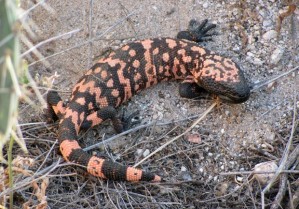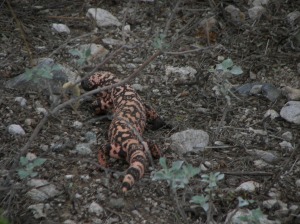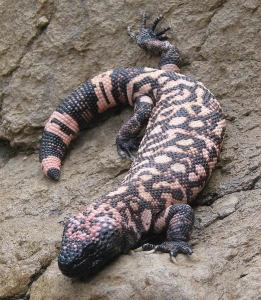The exotic color pattern of the gila monster (pronounced – Hee la) is black with pinkish or yellow spots and bands. Its unusual skin is beaded in appearance. Native to the Sonoran Desert in Arizona and Mexico, the Gila Monster is a species of venomous lizards. This lizard is named for the Gila River in Arizona where they used to be abundant.

Towards late summer, gila monsters become active after thunderstorms. Although this lizard is venomous, it moves very slow and represents very little threat to us humans. People often kill gila monsters due to fears; even though it is protected under Arizona state law.
If you encounter a Gila monster remain calm. This lizard will move on if left alone. Alert anyone in the vicinity and keep your pets away. For questions or advice call your Game and Fish Department.

Do not worry or have fears; the Gila monster tries hard to avoid humans and other large animals. To warn off potential predators, gila monster lizards will open their mouth very wide and hiss.

What to do if you are bitten by a gila monster? — A Gila monster bite is painful to humans but rarely causes death. The biggest problem you will have is trying to get the lizard to release its grip! The bite is strong, you may need to fully submerge the biting lizard in water to break free from the bite. If there is no water, you can use a stick to pry the gila monster’s jaw open. Be careful after you have dislodged it.

Remain calm if bitten and get to a medical facility immediately. Remove all jewelry from the bitten limb and keep it below heart level. DO NOT use a constriction bandage or a tourniquet on a gila monster bite.

The Gila monster eats primarily reptile eggs, frogs, insects and worms – feeding only five to ten times a year in the wild. They have poor eyesight but an extremely acute sense of smell which they use to locate prey. The sense of smell of the gila monster is so keen that it can accurately follow a trail made by a rolling egg.
They live in burrows, thickets, and under rocks with ready access to moisture. Gila Monsters are solitary and live in desert and semidesert areas. They are inactive much of the time. When spring arrives, gila monsters begin to hunt again. During the summer the lizards only come out in the evening.

Breeding season for Gila monsters is usually early summer. The female digs a hole, lays a clutch of oval-shaped eggs. Four months later, the baby Gila monsters break out of their eggs and crawl to the surface. The Gila monster may live up to 20 years in the wild, or 30 in captivity. This heavy, slow-moving gila monster, is the only venomous lizard native to the United States and one of only two known species of venomous lizards in the world, the other being its close relative, the Mexican Beaded Lizard.

The beaded lizard is larger (2-3 feet in length) than the Gila monster (up to 2 feet in length); but has duller coloration with black and yellowish bands. The Mexican beaded lizard’s venom contains enzymes used in manufacturing drugs to treat diabetes. Once again people kill these lizards because of fears and superstitions. The beaded lizard is protected by Mexican law and it dwells within the range of several protected areas.

In 1952, the Gila monster, Heloderma suspectum, became the first venomous animal in North America to be given legal protection; it is illegal to “harass, harm, pursue, hunt, shoot, wound, kill, trap, capture, or collect the Gila Monster. Gila monsters are listed as Near Threatened.


Great post and very interesting .Regards.
LikeLike
Such a excellent blog you’ve here. Make sure you up-date it more frequently. This particular subjects is my personal interest. Thank you.
LikeLike
I love the way you take time to introduce us to the nature around you. While, I am still no fan of lizards, as all of them remind me of comodo dragons, I feel little more learned about them now. This little monster here, is a work of art, with those mesmerising colours and pattern, well captured pictures. Thank you for sharing.
LikeLike
thanks bittercharm and I’m glad you can see the beauty in the Gila Monster. He poses no threat to humans, yet MAN is its worst predator.
I’m not familiar with comodo dragons, I will have to read up on it 🙂
blessings,
Tj
LikeLike
It has pretty colors. What animals prey on the Gila Monster? Any plans to do a followup piece on Komodo dragons? (Although they’re not in Arizona as far as I know.)
LikeLike
Komodo dragons, interesting! shall be a future piece…. unless you write an article first 😀
Marcella for the Gila Monster predators, first you read that the Gila Monster is slow as molasses – The colors stick out like a soar thumb too – MAN is actually its worst predator, how sad…. but occasionally an owl, eagle, hawk, and rare but coyote.
LikeLike
Yes, it’s definitely a walking target.
No, I won’t be writing about a Komodo Dragon anytime soon; not unless they discover that it’s saliva cures cancer which is not likely. Remember when Sharon Stone’s ex-husband got bitten by one? He almost lost his toe. I think their bites are poisonous. My blog is for your Good health, not for your Bad health! LOL! I wouldn’t do it justice; that’s your domain. I’ll be looking forward to it.
LikeLike
Good point!
LikeLike
Wow! It really is dangerous in your region! 😉 Very interesting – I had never heard of this lizard before, and had no idea they can be venomous. We have tiny little lizards in comparison – about 10 inches at most! (There are loads of babies in our rockery – just a couple of inches long, but impossibly fast, so no photos!) Thanks Tj!
LikeLike
It is strange Cathy that the desert has strange creatures and spikey, dangerous plants. There is a beauty in there but one must be educated to mingle with a desert.
Oooo you have good lizard bug eaters! thanks for the comment, I was a bit behind but now I’m getting caught up on my blogging friends.
LikeLike